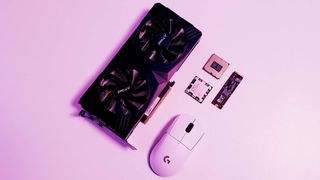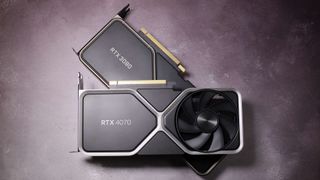Valve Hardware Survey for March—AMD still can't make a dent in Nvidia's massive lead
No major changes this month but that's hardly surprising

It's that time of the month again, when Valve publishes statistics for its latest hardware survey. All the key details about the different gaming PCs sampled are there for viewing and while the figures for March don't contain anything hugely significant, the long term trends show that PC gamers upgrading from older GPUs are mostly switching to Nvidia's latest RTX 40-series of graphics cards.
Not that this is in the least bit surprising, of course, as Nvidia has dominated Valve's GPU charts for a long time. But anyone hoping that AMD's RX 7000-series would make some headway in the survey will be disappointed, as the latest RDNA 3-powered chips have only improved by a tiny 0.1% of the survey share, matching the four years old RDNA 1 at 0.4% overall.
AMD's last generation of chips is still at 3.1% and a reasonable slice of that is the GPU in the OLED-version Steam Deck. Labelled as 'AMD Custom GPU 0405', that chip holds 0.67% of the total GPU share in the survey. While that might not look like much, it's AMD's fourth highest entry in Valve's GPU listing, with the Radeon RX 580 and a bunch of integrated GPUs coming ahead of the Steam Deck.
As for Nvidia, well it's graphics cards form a smidge under 72% of the total survey, with the GeForce RTX 30-series forming the largest part of this at 27.8%. The older GTX 10-series and RTX 20 and 16-series of cards have been slowly decreasing in the figures, and it's been the latest Ada Lovelace products that have filled those places.
Continuing with the theme of 'gee, no surprise there', it's the mainstream and budget products that were the most common in the sample. The GeForce RTX 3060 takes the top slot, with 6.71%, followed by its predecessor, the RTX 2060, with 3.98%. The most common 40-series cards are the RTX 4060 and RTX 4070, at 2.5% and 2.42% respectively.
If you think that means there are no mega-bucks cards near the top of the list, then think again. The wallet-conquering RTX 4090 is 30th and the RTX 4080 is only two positions lower.
As always, though, these figures can't quite be taken at face value, as without any information about the surveying method (e.g. sample size or geographic distribution), there's no way of telling just how representative Valve's survey is for PC gaming as a whole.
The biggest gaming news, reviews and hardware deals
Keep up to date with the most important stories and the best deals, as picked by the PC Gamer team.
That said, the industry doesn't completely ignore it, and will use the figures alongside other company data to determine what the potential user base for a game will be running with.
Beyond graphics chips, six-core CPUs form 34.8% of the survey share, with 8-core processors at 19.8%. Interestingly, CPUs with ten cores are at 5.62%, closely followed by 12, 14, and 16 core chips, showing that no small number of PC gamers sampled are using one of AMD or Intel's latest CPUs.

Best CPU for gaming: The top chips from Intel and AMD.
Best gaming motherboard: The right boards.
Best graphics card: Your perfect pixel-pusher awaits.
Best SSD for gaming: Get into the game ahead of the rest.
As for system RAM, almost half of the survey respondents had 16GB in their PCs, but 32GB systems increased from last month by 2% to reach 29.3%. Give it another year and I bet this figure will be a lot closer to the 16GB figure, as more big games start to require the larger amount of RAM.
And it's a similar picture with monitors, with 1080p panels taking the lion's share at 58% and 1440p at just under 20%. 4K remains at around 3.4% and doesn't show much sign of changing.
The one thing to note in the March figures is that the most common OS language used is Simplified Chinese, at 33.4%, whereas English is at 32.5%—the former has been consistently increasing in share over the last few surveys, and this can be attributed to the fact that there's only been a China-only version of Steam for a few years.
As the months roll on, I suspect that Chinese will be the number one language permanently, given the sheer number of PC gamers in that country.

Nick, gaming, and computers all first met in 1981, with the love affair starting on a Sinclair ZX81 in kit form and a book on ZX Basic. He ended up becoming a physics and IT teacher, but by the late 1990s decided it was time to cut his teeth writing for a long defunct UK tech site. He went on to do the same at Madonion, helping to write the help files for 3DMark and PCMark. After a short stint working at Beyond3D.com, Nick joined Futuremark (MadOnion rebranded) full-time, as editor-in-chief for its gaming and hardware section, YouGamers. After the site shutdown, he became an engineering and computing lecturer for many years, but missed the writing bug. Cue four years at TechSpot.com and over 100 long articles on anything and everything. He freely admits to being far too obsessed with GPUs and open world grindy RPGs, but who isn't these days?
Most Popular






